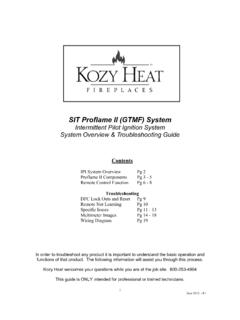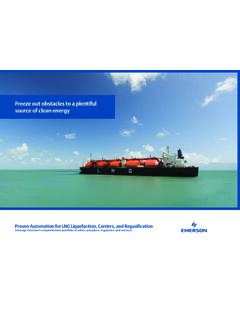Transcription of Hydraulic Training Manual - Main Filter Inc.
1 Hydraulic Training ManualArranged and produced byDefinition of HydraulicsIntroduction to HydraulicsDesigning a Simple Hydraulic CircuitPrinciples of HydraulicsContaminationSources of ContaminationThe Effects of ContaminationThe Costs of ContaminationComparison of Filter Types and LocationsFilter Test MethodsRating a FilterContentsHydraulics is a branch of science and engineering concerned with the use of fluids to perform mechanical tasks. It is part of the more general discipline of fluid word "hydraulics" comes from the Greek word hydraulikos which means water organ which in turn means water and , the fluid used in a Hydraulic system is an incompressible liquid such as a mineral based Hydraulic oil.
2 pressure is applied by a piston to fluid in a cylinder, causing the fluid to press on another piston that delivers energy to a load. If the areas of the two pistons are different, then the force applied to the first piston will be different from the force exerted by the second piston. This creates a mechanical change in pressure at any point in an enclosed fluid at rest is transmitted undiminished to all points in the principle is stated mathematically as: P = v( h)Definition of HydraulicsPascal s LawIntroduction to Hydraulics Variable Speed: The actuator (A device for converting energy into mechanical energy , a motor or cylinder.) in a Hydraulic system can be driven at different speeds.
3 Reversible: A Hydraulic actuator can be reversed instantly while in full motion without damage. Overload Protection: The pressure relief valve in a Hydraulic system protects the system from overload damage. Small Components: Hydraulic components, because of their high speed and pressure capabilities, can provide high power output with very small weight and size. Can Be Stalled: A Hydraulic actuator can be stalled without damage when overloaded, and will start up immediately when the load is reduced. Hydraulic Oil: The oil transmits power readily since it is minimally compressible. The most desirable property of the oil is its lubricating Hydraulic system is not a source of power.
4 The power source would be a prime mover such as an electric engine which drives the of HydraulicsBasic Hydraulic system with a linear Hydraulic ReservoirB Electric MotorC PumpD Maximum pressure Relief ValveE Directional ValveF Flow Control ValveG Right-angle Check ValveH Cylinder1. All circuit design must start with the job you want to achieve. For example; a weight to be lifted, a tool head to be rotated, or piece of work that must be clamped. 2. If the requirement were simply to raise a load, placing a Hydraulic cylinder under it would do the job. The stroke length of the cylinder would have to be at least equal to the distance the load must be moved.
5 3. The cylinder s area would be determined by the force required to raise the load and the desired operating pressure . For example; if an 8000 lb weight is to be raised a distance of 30 inches and the maximum operating pressure must be limited to 1000 psi then the cylinder selected would require a stroke length of at least 30 inches and with an 8 in 2 area piston it would provide a maximum force of 8000 lbs. However this, would not provide any margin for a Simple Hydraulic CircuitTo raise an 8000 lb load 30 inches, a cylinder with at least a 30 inch stroke is a Simple Hydraulic CircuitContinuedThe better selection would be a 10 in 2 cylinder permitting the load to be raised at 800 psi and providing the capability of lifting up to 10,000 lbs.
6 The upward and downward travel of the piston rod would be controlled by a directional valve. The rate at which the load must travel will determine the pump size. The 10 in 2 piston will displace 10 in 3 for every inch it lifts. Extending the piston rod 30 inches will require 300 in 3 of fluid. If it is to move at a rate of 10 inches per second, it will require 100 in3 of fluid per second or 6000 in3 per minute. Since pumps are usually rated in gallons per minute, the following conversion is necessary: 6000 231 26 gpmThe minimum pressure required to lift the load equals the load divided by the piston area. In this case 10 square 800psi minimum is needed to lift our load of 10 sq in 800 psiDesigning a Simple Hydraulic CircuitContinuedThe horsepower (hp) needed to drive the pump is a function of its delivery and the maximum pressure at which it may operate.
7 The following formula example will determine the size of the motor required: hp = gpm x psi x = 26 x 1000 x = To prevent overloading of the motor and to protect the pump and other components from excessive pressure due to overloads or stalling, a relief valve should be set to limit the maximum system pressure and installed in the line between the pump outlet and the pump inlet port to the directional valve (as shown in the adjacent diagram). A reservoir sized to hold approximately two to three times the pump capacity in gallons per minute, filters, and adequate piping would complete the systemElectric MotorRelief ValvePump delivery is directed to the cap end of the cylinderThe relief valve protects the system from over pressure by diverting the pump flow to tank when the maximum pressure setting is Rod ExtendsPumpDirectional ValveFlow indicated by switch oil is pushed out of the rod end and back to the of HydraulicsPressure results whenever there is resistance to fluid flow or to a force which attempts to make the fluid flow.
8 The tendency to cause flow (or the push) may be supplied by a mechanical pump or may be caused simply by the weight of the fluid. It is well known that pressure increases with depth in a body of water. The pressure is always equal at any particular depth due to the weight of the water above it. An Italian scientist named Torricelli proved that if a hole is made in the bottom of a tank of water, the water runs out faster when the tank is full and the flow rate decreases as the water level lowers. In other words, as the head of water above the opening lessens, so does the pressure . Torricelli expressed that the pressure at the bottom of the tank only as feet of head , or the height in feet of the column of water.
9 Today, with the pound per square inch (psi) as a unit pressure , we can express pressure anywhere in any liquid in more convenient terms. All that is required is knowing how much a cubic foot of the fluid weighs. How pressure is the total weight is 624 lbs. This weight is divided over 144 square inches. This gives us a pressure of psi at the bottom of the 10 foot column of of HydraulicsContinuedFlow is the action in the Hydraulic system that gives the actuator its motion. pressure gives the actuator its force, but flow is essential to cause movement. Flow in the Hydraulic system is created by the are two ways to measure the flow of a fluid: Velocity is the average speed of the fluid s particles past a given point or the average distance the particles travel per unit of time.
10 It is usually measured in feet per second (fps), feet per minute (fpm), or inches per second (ips). Flow rate is a measure of the volume of fluid passing a point in a given time. Large volumes are measured in gallons per minute (gpm). Small volumes may be expressed in cubic inches per minute. Bellow illustrates the distinction between velocity and flow rate. A constant flow of one gallon per minute either increases or decreases in velocity when the cross section of the pipe changes of FlowHow Flow is MeasuredThe speed of a Hydraulic actuator, always depends on the actuator s size and the rate of flow into it. Since the size of the actuator will generally be expressed in cubic inches, use this conversion factor:gpm = in3/minute231 Whenever a liquid is flowing, there must be a condition of unbalanced force to cause motion.



